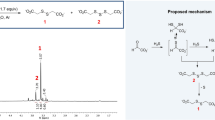Abstract
CHOLINE sulphate is synthesized by higher fungi1, algae2 and plants3. In fungi it is found in high concentration in the mycelium4 and in spores5 and is thought to act as a store of sulphur6,7 and possibly carbon and nitrogen. Synthesis of choline sulphate6,8 involves activation of inorganic sulphate by the enzymes ATP-sulphate adenylyltransferase (EC.2.7.7.4), (ATP-sulphurylase)and ATP-adenylyl 3′-phosphotransferase (EC.2.7.1.25), (APS-kinase), to give adenosine 3′-phosphate 5′-sulphatophosphate (PAPS) and the subsequent transfer of the sulphate group of PAPS to choline catalysed by 3′-phosphoadenylylsulphate: choline sulphotransferase (EC. 2.8.2) (choline sulphotransferase)9. The mechanism of the utilization of the sulphur of choline sulphate for cysteine synthesis has been in some doubt. A reversal of the choline sulphotransferase reaction to give PAPS which could then be converted to SO32− and then to cysteine has been ruled out9,10. Several workers have failed to detect a choline sulphatase in fungi11,12, and while this enzyme has been detected in A. sydowi and P. chrysogenum13, the activity of the enzyme was very low and its physiological significance uncertain. Evidence is now presented confirming the presence of choline sulphatase in fungi and establishing that this enzyme is obligatory for choline sulphate utilization.
This is a preview of subscription content, access via your institution
Access options
Subscribe to this journal
Receive 51 print issues and online access
$199.00 per year
only $3.90 per issue
Buy this article
- Purchase on Springer Link
- Instant access to full article PDF
Prices may be subject to local taxes which are calculated during checkout
Similar content being viewed by others
References
Harada, T., and Spencer, B., J. Gen. Microbiol., 22, 520 (1960).
Lindberg, B., Acta Chem. Scand., 9, 917 (1955).
Nissen, P., and Benson, A. A., Science, 134, 1759 (1961).
Woolley, D. W., and Peterson, W. H., J. Biol. Chem., 122, 213 (1937).
Takebe, I., J. Gen. App. Microbiol., 6, 83 (1960).
Spencer, B., and Harada, T., Biochem. J., 77, 305 (1960).
Takebe, I., and Yamagita, T., Plant and Cell Physiol., 1, 17 (1959).
Kaji, A., and McElroy, W. D., Biochim. Biophys. Acta, 30, 190 (1958).
Orsi, B. A., and Spencer, B., J. Biochem., 56, 81 (1964).
Kaji, A., and Gregory, J. D., J. Biol. Chem., 234, 3007 (1959).
Ballio, A., Brandl, E., Chain, E. B., Dentice di Accadia, F. D., Navazio, F., Rossi, C., and Ventura, M. T., Sci. Rep. Inst. Super. Sanita, 2, 243 (1959).
Itahasi, M., J. Biochem., 50, 52 (1961).
Segel, I. H., and Johnson, M. J., Biochim. Biophys. Acta, 69, 433 (1963).
Hockenhull, D. J. D., Biochim. Biophys. Acta, 3, 326 (1949).
Wilson, L. G., and Bandurski, R. S., J. Biol. Chem., 233, 975 (1958).
Horowitz, N. H., and Beadle, G. W., J. Biol. Chem., 150, 325 (1943).
Horowitz, N. H., J. Biol. Chem., 162, 413 (1946).
Author information
Authors and Affiliations
Rights and permissions
About this article
Cite this article
HUSSEY, C., ORSI, B., SCOTT, J. et al. Mechanism of Choline Sulphate Utilization in Fungi. Nature 207, 632–634 (1965). https://doi.org/10.1038/207632b0
Published:
Issue Date:
DOI: https://doi.org/10.1038/207632b0
This article is cited by
-
Isolation and characterisation of genes for sulphate activation and reduction in Aspergillus nidulans: implications for evolution of an allosteric control region by gene duplication
Molecular and General Genetics MGG (1995)
-
Genetic Analysis of the First Steps of Sulphate Metabolism in Aspergillus nidulans
Nature (1968)
-
A vegetative instability inAspergillus nidulans
Genetica (1967)
Comments
By submitting a comment you agree to abide by our Terms and Community Guidelines. If you find something abusive or that does not comply with our terms or guidelines please flag it as inappropriate.



